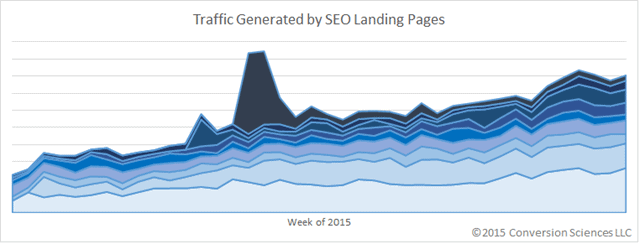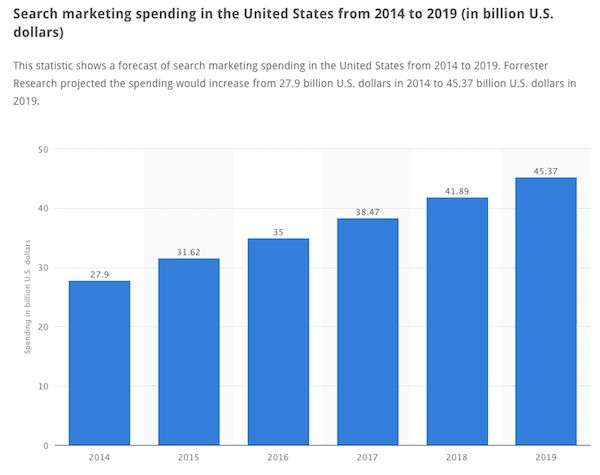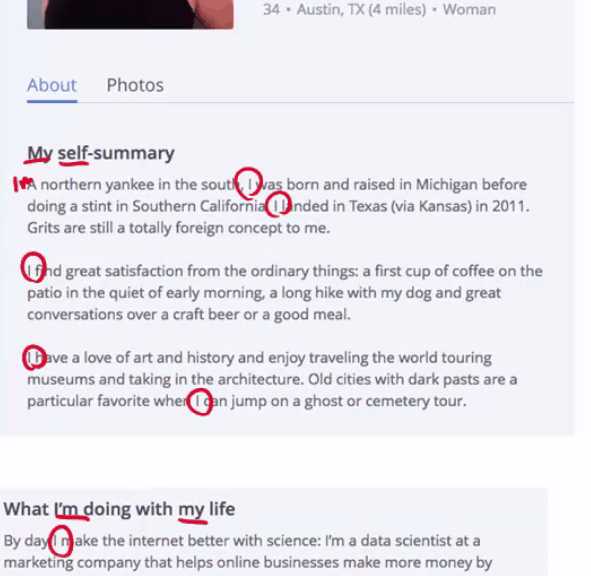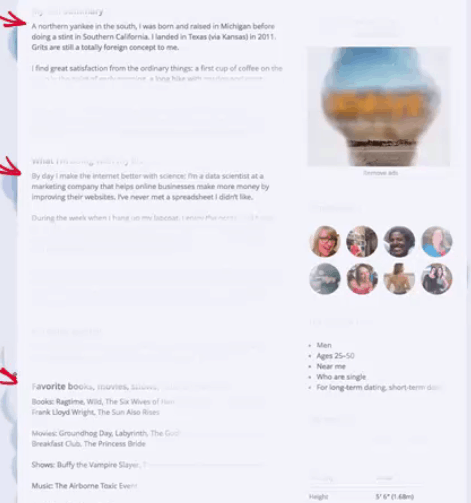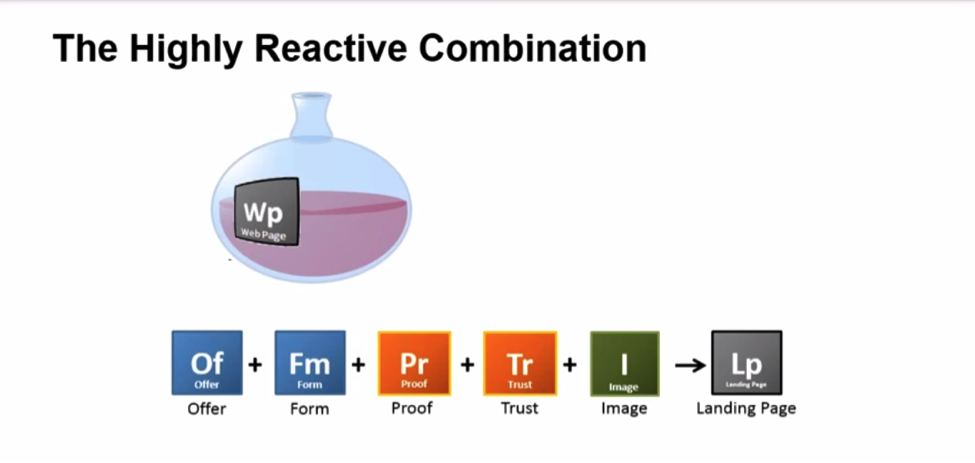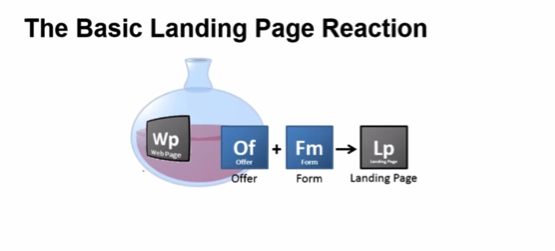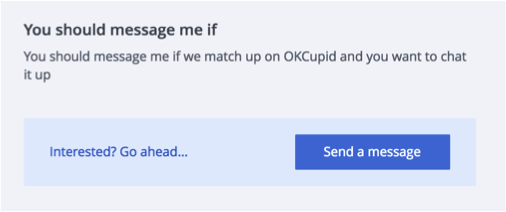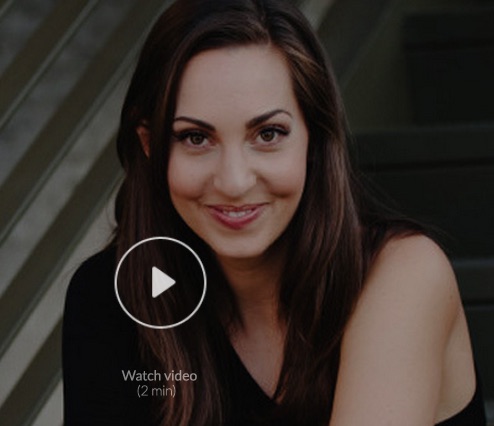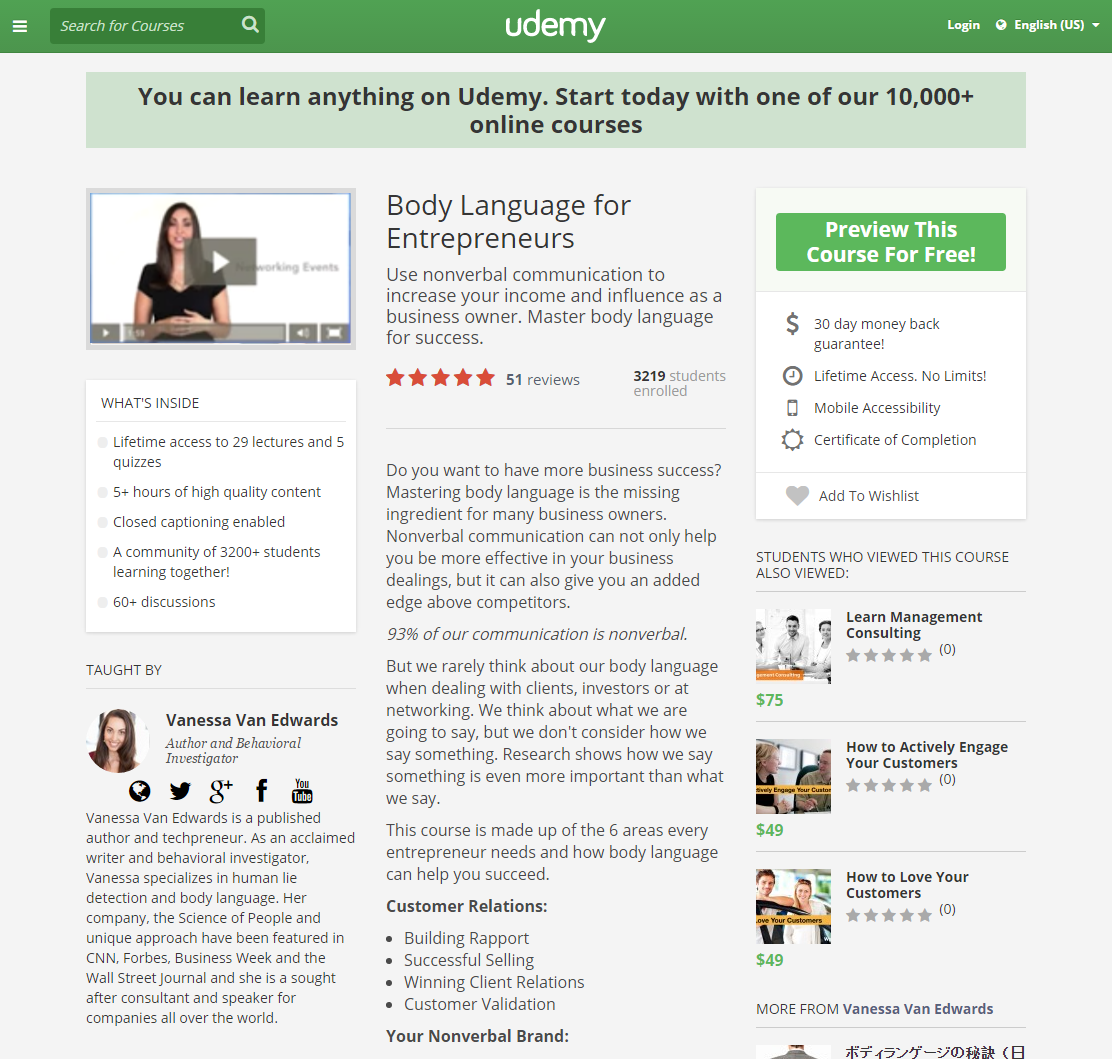As a scientist, I’m obsessed with data in every aspect of my life. I calculate wait times in lines based on number of customers and speed of the checkout clerk. I check multiple spreadsheets and websites to optimize cash back rewards and airline points before purchasing anything.
So when I decided it was time to look for a lab coat that matches mine, joining an online dating site with plenty of data points was the perfect choice for me.
My Online Dating Profile: The Most Romantic of Landing Pages
An online dating profile is essentially a lead generation landing page, so it’s the perfect platform to create an optimization project that’s entertaining to read about as well as fairly practical for me: a single woman looking for a dating partner.
Before we can attract the ideal date (or customer), we need to know how to measure “ideal”. Most of our visitors won’t be the ideal. We need to have a good understanding of our base qualifications and the deal-breakers that mark a visitor as outside our target market.
One of the most difficult questions a business can answer is, “Who do I not want to focus on?” or, “Who am I willing to let go of to better serve my best prospects?” If we try to speak to everyone with our value proposition, it gets watered down so much that we don’t engage any visitors effectively.
This is essential for efficiency in time and cost of acquisition.
You don’t want your sales staff spending hours with leads that will never be customers.
And I don’t want to spend hours with men that will never be a good date for me.
With this in mind, I’m putting aside the idea of a “match” in favor of looking for “leads”. However, not everyone is a good “lead” for me.
For this experiment to work I needed to be armed with a list of traits that could easily be spotted from a dating profile or early interaction, and a site with a lot of data points to examine.
I chose the free site okcupid because it has a large user base in my target market (Austin, TX) and uses both quantitative and qualitative data points which will make sussing out a qualified lead much easier.
With all this data at my fingertips, the job I have before me is to put together a rating system that will allow me to quantitatively judge what is a fairly subjective task.
But how do I do that?
The (Quite Literal) Formula for Love
For a dating landing page, I need to be able to numerically rate a lead – someone who messages me – instead of using my intuition, and I need to be able to gauge whether I’m attracting the kind of person I want to spend time with. Otherwise, I’m just congratulating myself on receiving mountains of messages with no regard to quality.
We experience the same challenges on landing pages. Our conversion rate tells us how many visitors respond to an offer, but we need another way to determine whether or not our page is engaging qualified prospects: quantity and quality.
Fortunately, my work as a data-driven analyst has prepared me for the task… I hope.
For my lead rating system, I will rate the profile based on observable evidence in his profile and initial message.
I’ve organized my rating system into three different levels:
- Free of deal-breaker traits (db) rated as a 0 or 1
- Traits that are of importance to me (ti) rated on a scale from 0 to 1
- Traits that are of critical importance to me (tomg) rated on a scale from 0 to 1
Note: this is weighted more heavily in our formula
It all boils down to this First Date Probability formula:
P(first date) = db x (∑ti x 2∑tomg)
Deal-Breakers
The deal-breaker variable is binary. If a curious courter has even one deal-breaker trait, his First Date Probability goes to zero.
In both the dating world and the business world, deal-breakers are pretty important. They quickly eliminate prospective paramours from the running early on. Businesses, however, don’t often incorporate these all-or-nothing deal-breakers in lead scoring algorithms.
What are the deal-breakers in your online business? We all want web prospects that have a problem you can solve, and who have the money to pay for it.
Common business deal breakers include:
- Title: They don’t have the authority to make the decision.
- Purchase Timeframe: They aren’t ready to buy in a reasonable time.
- Location: We can’t service their city.
- Language: We can’t communicate with them.
- Budget: They can’t afford us.
At my company, we really can’t do scientific optimization unless a prospect gets 200 transactions or leads from the web in a month. For us, this is a deal-breaker.
Asking about deal breakers in your lead generating landing page forms is one way to let visitors know that they are in the wrong place. They won’t waste your time and you won’t waste theirs.
Deal-breakers for me include:
- Younger than 25 or older than 45
- Already in a relationship or not interested in monogamy
- Living outside of Austin, Texas
- Smokers
I would score these with a zero if I find them in his profile.


Finding evidence of my deal-breakers is pretty easy on okcupid as these are simple questions provided in a basic profile. Either you’re a smoker, or you’re not. Here are some of my answers, totally spelled out for me – 37, non-smoker, Strictly Monogamous, Lives in Austin, Texas.
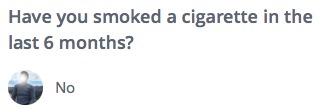
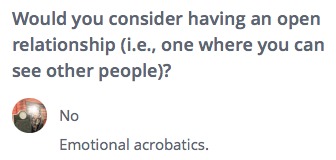
If a lurking Lothario contacts me who is prison-bound for living out the storyline of Psycho, I will say “no” to a date and consider none of the other attributes. If these items are present, the inquirer receives an appropriate rating of 0.
For our experiment, anyone who contacts me outside of this range will still be considered a lead, but they’ll just be an unqualified lead. In business, these are the folks we just can’t help. They might get a short, polite email or a referral to a more suitable business.
Important Traits (ti)
This next group of traits aren’t deal-breakers. I’m willing to make compromises here, though they’re still important.
In my formula, I will find a value for important traits (ti) by finding the sum of rated items. Some items will get a negative rating, meaning a score of one will be subtracted from the total.
- Negative Rating: If there is a religious mismatch, a prospective Romeo will get a negative rating. It’s important that we have similar values.
- College graduate – Tells me he values and respects education. And he can read. I’m most turned on by smarts, so someone with a well exercised brain is a must.
- Adventurousness – Not afraid to try new kinds of foods, sky-diving, road trips — almost anything you couldn’t do in your cubicle.
- Love of travel – Traveling is part of being adventurous, but it’s also a distinct part of my rating system. I have friends all over the country and would like to hear more about interesting places.
- Appreciates dry/sarcastic humor – My sarcastic voice sounds a lot like my regular voice (bonus points for Joss Whedon fanboys and knowing where that line comes from)
- Creative and appreciates art – Creative hobby a plus! (I dance, love the theater, paint and write – I want someone that can come with me to the theater or an art museum.)
- Healthy/physically active lifestyle – It isn’t about body type; it’s about lifestyle. I’d love to find someone who will join me at the gym or go hiking with me.
You can that rating leads based on these traits isn’t going to be as straightforward as the deal-breakers, but it can still be pretty clear whether someone is stacking up well.
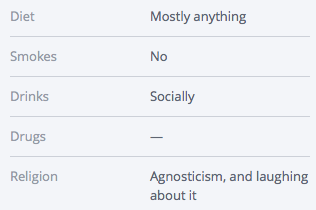
This snippet of standardized questions helps me get an idea of how this person feels about his religious beliefs. It’s actually a two part question answered by choosing your answer from a drop down menu. Part one is choosing the religion, and part two is where you choose the degree to which you follow the religion.

This question is open-ended, but this guy still managed to cover one of my important traits and also a critically important trait by mentioning his dog.
It won’t always be easy to assign a value, however. Sometimes I’m going to have to look at the profile as a whole to make a decision. This next profile gave me some mixed messages.


When you answer standardized questions on okcupid, it will use your answers to rank you among other users of the site. In the bar graph above, the midline represents the average okcupid user, so this person is much less into exercise than the average person.
But he has also indicated that he rides his bike often in his response to an open-ended question. Since I’m looking for someone who lives a healthy lifestyle, maybe not exercising is ok. It could mean that he just really hates going to the gym, but he loves being an active person.
Critically Important Traits (tomg)
- 27-37 years of age
- Loves dogs – I own a giant dog named Remus and he’s here to stay.
- Negative Rating: Negativity and pessimism.
- Career oriented – My ideal match has his own career and professional direction because he’ll understand my own ambition, and we’ll be able to encourage and support each other.
- Enjoys quiet evening at home – I love being downtown or out where the action is, but I need quiet and mellow to recharge and be my best.
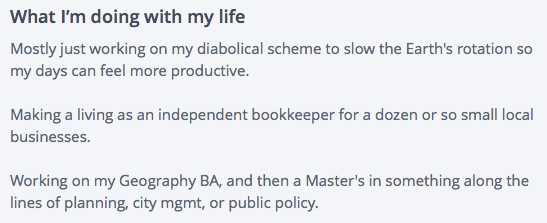
If this person contacted me, he would be a strong lead based on this small part of his profile. Humor? Check. Career oriented? Check! Education? Check. There are many personality traits I’m looking for that I didn’t include in my rating system because I wasn’t sure I’d be able to find solid evidence without meeting in person, but this guy is also demonstrating some strong elements of the Type A personality I really like.
Deciding whether someone is negative or pessimistic will be another item that requires looking at the big picture. It’s one of those “know it when you see it” traits, but strong indicators are lists of unacceptable attributes in another person and making repeated comments about how past relationships have ended poorly.
Scoring Qualified Leads
So now what? We have a bunch of leads that aren’t obvious mismatches. How do we determine which ones to spend our time and energy on? Who will have the highest ROI?
For our experiment we’ll count a lead as anyone that initiates contact. We’ll then rank our leads based on the following system:
Qualified lead: Scores a one on all deal-breakers (meaning there aren’t any deal-breakers I could find)
These are the profiles I’ll take time to look at and see if they’re worth spending time on.
Ideal candidate: Scores zero on all negative ratings and ones across the board other than that. We can skip the screening portion and start lobbying hardcore.
Candidate Level 1: Scores in the top third of my formula.
I will devote time and energy talking to this person and getting to know him with an emphasis on setting up an in-person meeting sooner rather than later.
Candidate Level 2: Scores in the middle third of my formula.
I will respond to his message and ask leading questions. He may have other qualifications that are not on the list that appeal to me, so he might be worth an in-person meeting.
Candidate Level 3: Scores in the bottom third of my formula.
These are the leads that are worth talking to if times are lean. If lead flow is up, and we’re swimming in qualified leads, these will fall to the bottom of the pile. We’ll get to them if we have the time and resources to do so.
Case Study
To see how well my equation works on a real person, I’m putting it to the test. The screenshots below are from a single profile. He hasn’t messaged me, so he doesn’t count as a lead for my experiment, but he should be good practice for my rating system.
I’ve started with profile basics looking for deal breakers.

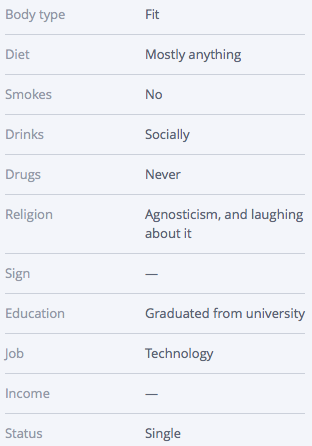

Deal-Breaker Traits
- Younger than 25 or older than 45: 1
- Already in a relationship or not interested in monogamy: 1
- Living outside of Austin, Texas: 1
- Smokers: 1
He’s off to a good start, so now I’m moving on to look for important traits. Some of them popped up in his profile basics.
Important Traits
- Negative Rating – Religious mismatch: 1
- College graduate: 1
He’s agnostic, and I’m Episcopalian. We might be able to make it work, however, which is why this trait isn’t a deal breaker.

- Adventurousness: 1
- Love of travel: 1
- Healthy/physically active lifestyle: 1
He describes himself as fit in his profile basics which made me think he probably leads a pretty healthy lifestyle, but this paragraph made me certain.
He also has a tone here that seems humorous when he says he runs for his own “feel goods”. I wanted to give him a score of one based on that line, but it seemed like it would be based on fairly thin evidence. His self-summary gave me more data to make me think a score of one is appropriate.
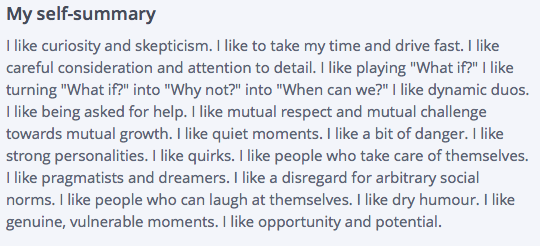
- Appreciates dry/sarcastic humor: 1
- Creative and appreciates art: 0
I looked for responses to questions about art, photos that could be in a museum, mentions of favorite artists, but I didn’t see anything artistic.
He didn’t nail all of my Important Traits in his profile, but I still found evidence of most of them. Now for Critically Important Traits.
Critically Important Traits
- 27-37 years of age: 1
- Loves dogs: 1
- Negative Rating – Negativity and pessimism: 0
I found his age and pet ownership status in his profile basics.
Of course I can’t prove the null hypothesis with negativity since I’m trying to figure out whether he isn’t a positive person, so it’s possible that he’s a pessimist. That’s what makes this trait one of the more difficult ones to score – but there wasn’t enough evidence to give him anything other than a zero.

- Career oriented: 1
- Enjoys quiet evening at home: 1
If he wants to spend Friday night talking about business ideas, I can say with confidence that he’s a career oriented person. Takeout, movies, and TV shows all sound like a solid night in to me.
Now I can plug in some numbers into my formula.
P(first date) = db x (∑ti x 2∑tomg)
db = 1
∑ti = 3
∑tomg = 4
P(first date) = 1 x (3 x 2(4))
P(first date) = 24
He is a candidate level one using my criteria. Let’s hope he sends me a message!
Attracting Ideal Qualified Leads
It may turn out that people aren’t up front about something I thought they would be or that a particular flaw that bugs me turns out to be so common that I would be remiss to keep paying attention to it. So I may need to make adjustments here and there in my description of an ideal lead.
The process of creating my rating system, however frustrating, was a good experience because knowing what I’m looking for is half the battle. I now know what I’m aiming for in my profile/landing page, and I can share things about myself more strategically. I won’t be lying on my dating profile, so when I say I’m being strategic, I’m not changing who I am to meet someone – I’m simply emphasizing certain things about myself and not mentioning other things.
Best foot forward, right? Your landing pages should do the same. If you’re a family-oriented small business, but your ideal lead isn’t, why share that information? It’s still important, of course, but it’s ok to withhold information that doesn’t get right to the point.
Now you know quite a lot about what I’m looking for, but you know relatively little about me personally. To find out more, you know what to do: subscribe to my series! You know you want to…












